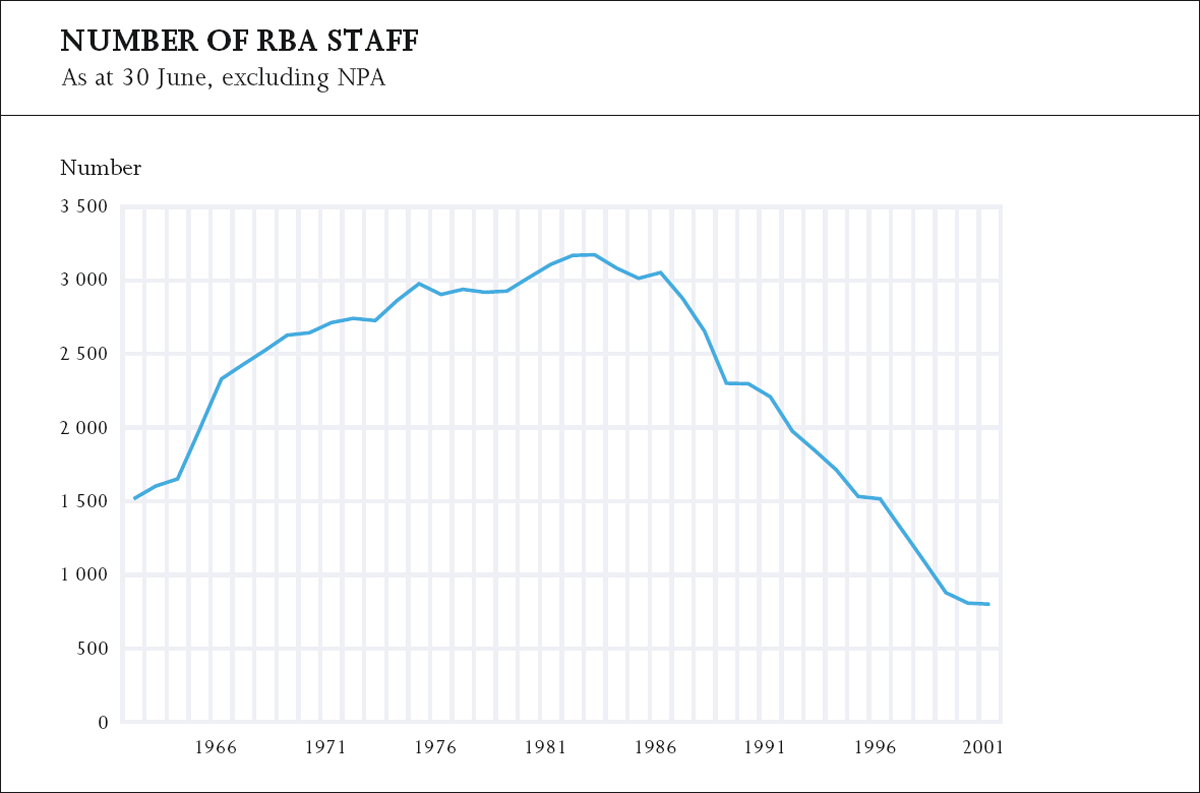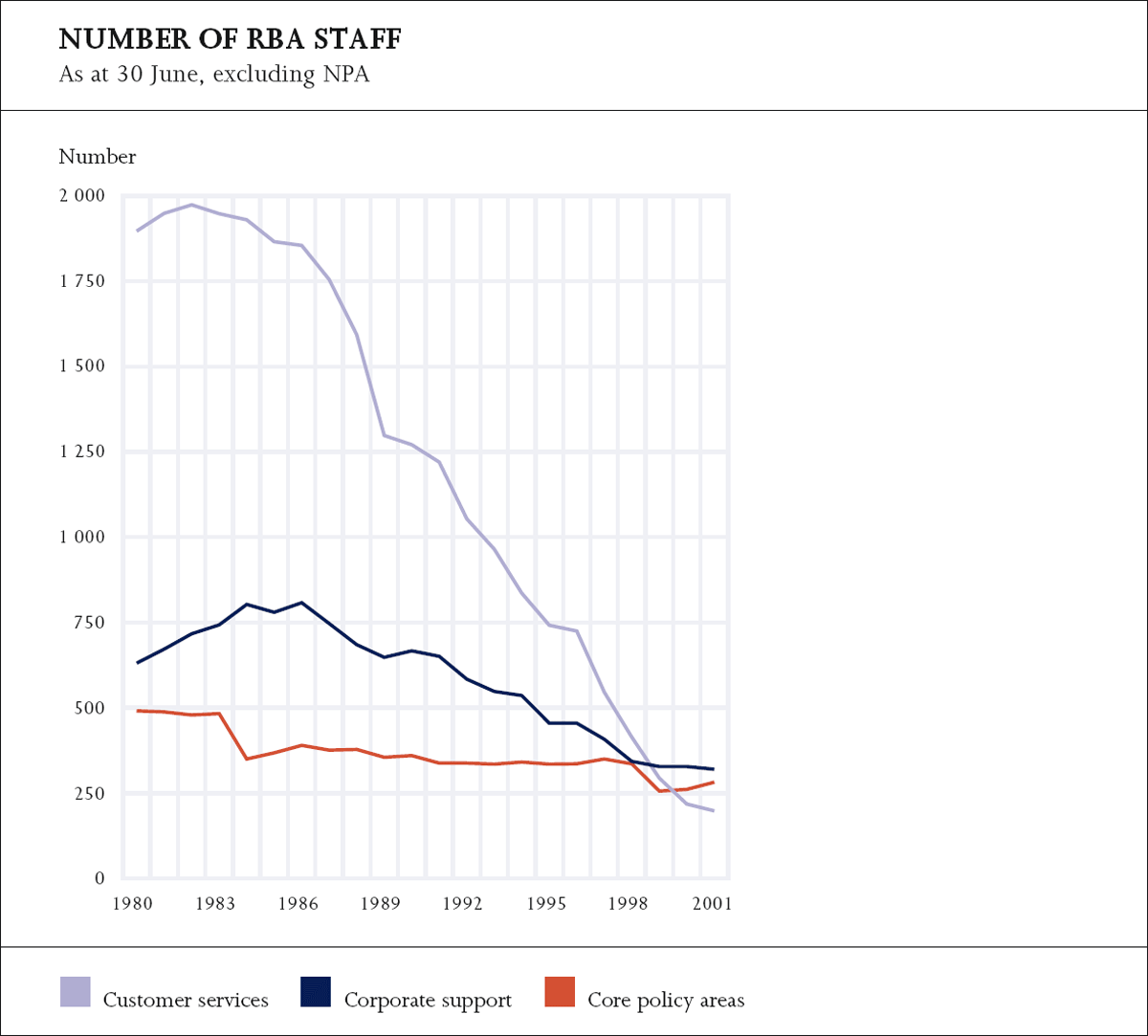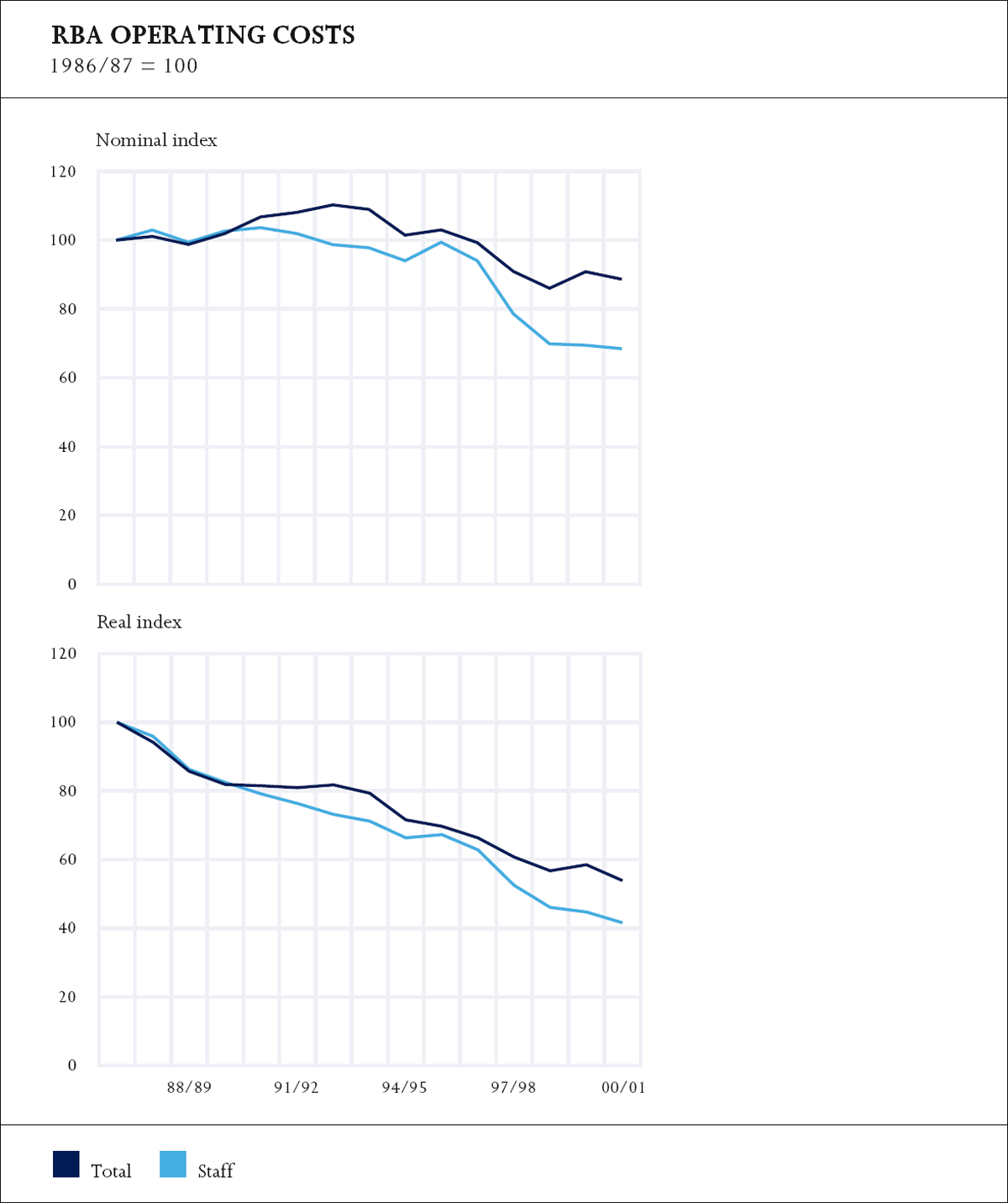Reserve Bank of Australia Annual Report – 2001 Administration and Costs
With the RBA having absorbed major restructuring and staff reductions over a run of years, the management challenges of the past year were perhaps less demanding, although the business areas of the RBA continued to adjust to the highly competitive environment and some new areas of responsibility were resourced.
As discussed in the chapter on ‘Business Services’, the new National Note Processing Centre (NNPC) commenced operation in June 2001, and the Sydney cash-processing function was closed. All of the RBA's note-processing activities are now centralised at the NNPC, which has a staff complement of 20, with a further 28 staff employed in Head Office to administer note-issue policy and conduct research on related matters. In the mid 1980s, about 650 staff were employed in note-issue activities at the RBA's Head Office and branches around Australia.
The final steps in reorganising banking operations in Sydney and Canberra were implemented, with staff employed in banking operations in the RBA set to fall to about 90, compared with about 850 in the mid 1980s. This further restructuring places the RBA in a good position to bid competitively as Commonwealth Government agencies continue the process of market-testing their transactional banking needs.
The scaling down of cash operations and banking services in recent years had been concentrated in the RBA's branches, most of which as a result had become unviable. The pressure on branches was aggravated by the loss of some State governments as banking customers. Over recent years, the RBA's branches in Melbourne, Brisbane, Perth, Hobart and Darwin have been closed. The branch in Canberra remains open to provide banking services to the Commonwealth, while that in Adelaide still conducts banking for the South Australian Government.
The RBA has now established Regional Offices in Melbourne, Brisbane and Perth, and placed an economist in the branch in Adelaide, to gather at first-hand intelligence about local economic conditions and to improve communication between the RBA and the community more generally. The number of staff engaged directly in analysing regional economies now totals about 15 and their activities are co-ordinated by Economic Analysis Department.
Following a review of the various channels by which the RBA provides information to the community, a new department, Information Department, was created with responsibility for the RBA's print and electronic information services and its relationship with the media. This change, in turn, permitted a streamlining of Secretary's Department, to give it a sharper focus on Board matters, relations with governments and legal affairs.
A range of personnel functions, which had previously been dispersed in a number of departments, was consolidated in Personnel Department, which has a brief to continue to develop policies more suitable to staffing a smaller organisation with a more mobile workforce. The Personnel Policy and Support Services Departments were abolished.
Overall in 2000/01, there was little change in the number of staff, at 800, as contraction in some parts of the RBA was offset by growth in new and expanded functions.


A process of modernising workplace arrangements in the RBA has been in train for some years. As occurred with senior staff in 1999/2000, the assistance of external consultants was sought during the past year to benchmark the responsibilities and remuneration for middle-managerial positions. Following this review, these staff were offered individual employment contracts, in which access to certain benefits, including rostered days and the provision of housing loans through the Officers' Homes Advances scheme, was discontinued. Most staff to whom these contracts were offered accepted them. About 33 per cent of the RBA's staff are now employed under individual employment contracts. Among senior and managerial staff, the proportion is over 80 per cent.
Changes in the conditions of other staff are generally negotiated as part of an enterprise bargaining agreement. A new enterprise agreement was negotiated during the past year, to apply to the calendar years 2001 and 2002. This agreement simplifies a number of the RBA's administrative practices in order to promote opportunities for part-time work, and enhance merit selection processes. Separately, access to the Officers' Homes Advances scheme will no longer be offered to new employees.
The Governors, staff employed under individual employment contracts and other staff received salary increases of 3.5 per cent in July 2000. Staff covered by the RBA's 2001 enterprise agreement received a further 3.8 per cent from July 2001.
In order to continue to attract staff of high quality, the RBA reformed aspects of its recruitment practices in 2000/01. It also continued its commitment to the development of existing staff, with six staff currently undertaking full-time post-graduate study at universities in Australia and overseas under the Post-Graduate Study Award Scheme. This scheme is currently being reviewed to ensure that it remains appropriate to the RBA's needs. The RBA provided financial support to 64 staff undertaking part-time tertiary studies in Australia. Under the New Apprenticeship Scheme, the RBA employed 15 trainees in the fields of business administration, information technology and print design.
Operating Costs
Notwithstanding the increase in salaries of 3.5 per cent in July 2000, staff costs fell, largely because of the full-year effect of closing branches and other savings in banking and note issue that occurred in 1999/2000. The RBA's total staff costs are now 30 per cent lower, in nominal terms, than they were in 1993/94. In real terms, the fall is much larger.
Total operating costs declined by more than staff costs in 2000/01 because costs in the previous year were boosted by expenses related to distributing currency around Y2K. Operating costs for 2000/01 are higher than in 1998/99, i.e. prior to the Y2K increase, partly because of the cost of establishing the Regional Offices. Nevertheless, as with staff costs, total operating costs are substantially lower, in nominal and real terms, than they were a decade ago.

| 1993/94 | 1994/95 | 1995/96 | 1996/97 | 1997/98 | 1998/99 | 1999/2000 | 2000/01 | |
|---|---|---|---|---|---|---|---|---|
| Staff costs | 96.7 | 93.0 | 98.3 | 93.0 | 77.7 | 69.1 | 68.7 | 67.7 |
| Other costs | 53.0 | 46.4 | 43.2 | 43.4 | 47.2 | 49.1 | 56.1 | 54.1 |
| Underlying operating costs | 149.7 | 139.4 | 141.5 | 136.4 | 124.9 | 118.2 | 124.8 | 121.8 |
| Cost of redundancies | 9.8 | 18.0 | 1.3 | 7.5 | 20.7 | 18.4 | 9.3 | 2.6 |
| (a) Costs associated with the ongoing operation of the RBA, excluding NPA | ||||||||
| Monetary Policy | Financial System Surveillance | Note Distribution | Banking and Registry | Settlement | |
|---|---|---|---|---|---|
| 1996/97 | 29 | 14 | 28 | 23 | 6 |
| 1997/98 | 30 | 14 | 23 | 23 | 10 |
| 1998/99 | 35 | 8 | 20 | 23 | 14 |
| 1999/2000 | 35 | 8 | 23 | 20 | 14 |
| 2000/01 | 41 | 9 | 17 | 18 | 15 |
| (a) Excludes NPA | |||||
The share of costs attributable to note distribution decreased in 2000/01, reflecting the reversal of the Y2K-related impact referred to above. Excluding this influence, however, the share of costs associated with note distribution has been on a downward trend for several years. This Y2K-effect also distorted the share of costs due to the RBA's other functions in 1999/2000. Looking beyond this, the share of costs related to monetary policy has tended to rise, partly due in 2000/01 to the effect of establishing the Regional Offices. The share from banking has tended to fall while that for providing settlement services had increased as the RTGS system was developed but has since steadied.
Occupational Health and Safety
The RBA holds a licence to self-insure and manage its workers' compensation claims. The licence has been renewed for a further three years by the Safety Rehabilitation and Compensation (SRC) Commission. While the RBA periodically reviews alternative insurance options, the small number of claims and low costs of in-house administration continue to favour self-insurance.
This year, the RBA presented the SRC Commission with the RBA's first Management Systems Review and Improvement Program (MSRIP) report. The MSRIP report assesses the effectiveness of systems for managing health and safety, compensation and rehabilitation programs. The report provides an overview of the RBA's OH&S performance, its claims experience and its rehabilitation record. On the basis of its performance during the year, the RBA's licence fee for 2001/02 will be 38 per cent lower than for the previous year.
Facilities Management
A major effect of the reduction in staff and closing of most branches is that the premises the RBA owns exceed its current needs. During the year, the RBA sold the building in which its branch in Brisbane had been located, for a sum of $13.5 million. The RBA has also begun negotiations to sell its buildings in Hobart and Perth. The building in Melbourne will be retained to support cash processing at the NNPC, house the RBA's Victorian Regional Office and accommodate external tenants.
While the reduction in the RBA's staffing was concentrated in the branches, the number of staff in Head Office has declined by about 40 per cent from its peak. After reviewing the use of the Head Office building, the RBA decided to make better use of the space available by consolidating its operations. This project, involving a major program of works, will convert currently under-used space into useable office space; consolidate the RBA's functions to use less space and do so more efficiently; and lease the resulting surplus space (about 20 per cent of the building) to suitable external tenants.
In accordance with the provisions of the Public Works Committee Act 1969 the project was referred to the Joint Standing Committee on Public Works for consideration and report. The Committee's report, which followed a Public Inquiry and written submissions from the RBA and other interested parties, recommended that the works proceed at an estimated cost of $21.5 million. This recommendation was endorsed by Parliament in early December 2000.
Since the Parliament's approval, the detailed design of the project has been proceeding. Tenders for the main works were issued in mid May. These works are expected to begin in late August 2001 and continue for around 18 months. As part of a detailed design process, and in recognition of the heritage worth of the building, the RBA commissioned a conservation management plan and heritage impact statement to ensure that the proposed works would not impact adversely on the character of the building.